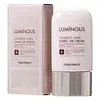What's inside
What's inside
 Key Ingredients
Key Ingredients

 Benefits
Benefits

 Concerns
Concerns

 Ingredients Side-by-side
Ingredients Side-by-side

Titanium Dioxide
Cosmetic ColorantZinc Oxide
Cosmetic ColorantWater
Skin ConditioningUndecane
EmollientTriethylhexanoin
MaskingCaprylyl Methicone
Skin ConditioningButyloctyl Salicylate
Skin ConditioningSilica
AbrasiveTridecane
PerfumingDicaprylyl Carbonate
EmollientDicaprylyl Ether
EmollientDimethicone/PEG-10/15 Crosspolymer
Aluminum Stearate
Cosmetic ColorantPentylene Glycol
Skin ConditioningPEG-9
HumectantAlumina
AbrasivePolyhydroxystearic Acid
EmulsifyingPhenoxyethanol
PreservativeMagnesium Sulfate
Propylene Glycol
HumectantCaprylyl Glycol
EmollientDisteardimonium Hectorite
StabilisingTriethoxycaprylylsilane
Diethylhexyl Syringylidenemalonate
Skin ProtectingPropylene Carbonate
SolventCassia Alata Leaf Extract
AstringentMaltodextrin
AbsorbentTitanium Dioxide, Zinc Oxide, Water, Undecane, Triethylhexanoin, Caprylyl Methicone, Butyloctyl Salicylate, Silica, Tridecane, Dicaprylyl Carbonate, Dicaprylyl Ether, Dimethicone/PEG-10/15 Crosspolymer, Aluminum Stearate, Pentylene Glycol, PEG-9, Alumina, Polyhydroxystearic Acid, Phenoxyethanol, Magnesium Sulfate, Propylene Glycol, Caprylyl Glycol, Disteardimonium Hectorite, Triethoxycaprylylsilane, Diethylhexyl Syringylidenemalonate, Propylene Carbonate, Cassia Alata Leaf Extract, Maltodextrin
Water
Skin ConditioningCyclopentasiloxane
EmollientCI 77891
Cosmetic ColorantEthylhexyl Methoxycinnamate
UV AbsorberDiphenyl Dimethicone/Vinyl Diphenyl Dimethicone/Silsesquioxane Crosspolymer
Diphenylsiloxy Phenyl Trimethicone
Skin ConditioningPhenyl Trimethicone
Skin ConditioningMethyl Trimethicone
Skin ConditioningIsotridecyl Isononanoate
EmollientLauryl PEG-10 Tris(Trimethylsiloxy)Silylethyl Dimethicone
EmulsifyingNiacinamide
SmoothingVinyl Dimethicone/Methicone Silsesquioxane Crosspolymer
Glycerin
HumectantPolymethylsilsesquioxane
Leontopodium Alpinum Flower/Leaf Extract
Skin ConditioningZea Mays Starch
AbsorbentNelumbo Nucifera Flower Water
TonicGossypium Herbaceum Extract
Skin ConditioningButylene Glycol
HumectantTourmaline
Pearl Powder
Amethyst Powder
AbrasiveNephrite Powder
AbrasiveSapphire Powder
Ruby Powder
Skin ConditioningDiamond Powder
AbrasiveRosa Damascena Flower Water
MaskingLilium Tigrinum Extract
Skin ConditioningLilium Tigrinum Flower/Leaf/Stem Extract
Skin ConditioningScutellaria Baicalensis Root Extract
AstringentPropolis Extract
Skin ConditioningSilk Amino Acids
HumectantRoyal Jelly Extract
Skin ConditioningCamellia Japonica Flower Extract
EmollientLonicera Japonica Flower Extract
Skin ConditioningAluminum Hydroxide
EmollientCetyl PEG/PPG-10/1 Dimethicone
EmulsifyingDimethicone/Vinyl Dimethicone Crosspolymer
Skin ConditioningDisodium Stearoyl Glutamate
CleansingVp/Hexadecene Copolymer
Disteardimonium Hectorite
StabilisingTriethoxycaprylylsilane
Dimethicone
EmollientAdenosine
Skin ConditioningSodium Chloride
Masking1,2-Hexanediol
Skin ConditioningCaprylyl Glycol
EmollientEthyl Hexanediol
SolventEthylhexylglycerin
Skin ConditioningParfum
MaskingMica
Cosmetic ColorantCI 77492
Cosmetic ColorantCI 77491
Cosmetic ColorantCI 77499
Cosmetic ColorantWater, Cyclopentasiloxane, CI 77891, Ethylhexyl Methoxycinnamate, Diphenyl Dimethicone/Vinyl Diphenyl Dimethicone/Silsesquioxane Crosspolymer, Diphenylsiloxy Phenyl Trimethicone, Phenyl Trimethicone, Methyl Trimethicone, Isotridecyl Isononanoate, Lauryl PEG-10 Tris(Trimethylsiloxy)Silylethyl Dimethicone, Niacinamide, Vinyl Dimethicone/Methicone Silsesquioxane Crosspolymer, Glycerin, Polymethylsilsesquioxane, Leontopodium Alpinum Flower/Leaf Extract, Zea Mays Starch, Nelumbo Nucifera Flower Water, Gossypium Herbaceum Extract, Butylene Glycol, Tourmaline, Pearl Powder, Amethyst Powder, Nephrite Powder, Sapphire Powder, Ruby Powder, Diamond Powder, Rosa Damascena Flower Water, Lilium Tigrinum Extract, Lilium Tigrinum Flower/Leaf/Stem Extract, Scutellaria Baicalensis Root Extract, Propolis Extract, Silk Amino Acids, Royal Jelly Extract, Camellia Japonica Flower Extract, Lonicera Japonica Flower Extract, Aluminum Hydroxide, Cetyl PEG/PPG-10/1 Dimethicone, Dimethicone/Vinyl Dimethicone Crosspolymer, Disodium Stearoyl Glutamate, Vp/Hexadecene Copolymer, Disteardimonium Hectorite, Triethoxycaprylylsilane, Dimethicone, Adenosine, Sodium Chloride, 1,2-Hexanediol, Caprylyl Glycol, Ethyl Hexanediol, Ethylhexylglycerin, Parfum, Mica, CI 77492, CI 77491, CI 77499
Ingredients Explained
These ingredients are found in both products.
Ingredients higher up in an ingredient list are typically present in a larger amount.
Caprylyl Glycol is a humectant and emollient, meaning it attracts and preserves moisture.
It is a common ingredient in many products, especially those designed to hydrate skin. The primary benefits are retaining moisture, skin softening, and promoting a healthy skin barrier.
Though Caprylyl Glycol is an alcohol derived from fatty acids, it is not the kind that can dry out skin.
This ingredient is also used as a preservative to extend the life of products. It has slight antimicrobial properties.
Learn more about Caprylyl GlycolDisteardimonium Hectorite comes from the clay mineral named hectorite. It is used to add thickness to a product.
It can also help stabilize a product by helping to disperse other ingredients.
Hectorite is a rare, white clay mineral.
Learn more about Disteardimonium HectoriteTriethoxycaprylylsilane is a silicone used to bind and stabilize ingredients.
As an emulsifier, it helps prevent ingredients from separating. This can help elongate the shelf life of products.
Triethoxycaprylylsilane is often used to coat mineral sunscreens ingredients to help give a better feel. It also helps reduce oxidative stress in sunscreens.
Learn more about TriethoxycaprylylsilaneWater. It's the most common cosmetic ingredient of all. You'll usually see it at the top of ingredient lists, meaning that it makes up the largest part of the product.
So why is it so popular? Water most often acts as a solvent - this means that it helps dissolve other ingredients into the formulation.
You'll also recognize water as that liquid we all need to stay alive. If you see this, drink a glass of water. Stay hydrated!
Learn more about Water